Parking Day this Friday | An in-street restaurant patio for Takoma Beverage Co. using parking spaces, Carroll Avenue, Takoma Park, Maryland

The group Rebar declared Sept. 21 "Park(ing) Day" and installed this temporary park in a parking space on Mission St. in downtown San Francisco, CA. The group moved the park to several different parking spaces throughout the day. Port-a-park: A temporary park was set up in a parking space on Mission Street by Rebar, an art collective. The park was moved several times that day. Chronicle photo by Laura Morton.
In 2006, a planning/artist collective in San Francisco called Rebar Group created what they called "Parking Day," to demonstrate the high cost to placemaking from dedicating so much public space to the automobile, for car storage ("Drop a coin in the meter and enjoy the park," John King,San Francisco Chronicle, 2006)
This event has become a world-wide phenomenon, existing and expanding beyond that of Re:bar which disbanded a couple years ago.
But Parking Day is important in how it sparked a greater focus on placemaking and public space not just within planning departments but also transportation departments and citizen advocates.
And it continues, as it will be held this Friday, and is held every year on the Third Friday in September.
-- ASLA Parking Day webpage (the Parkingday.org web domain is somewhat lost but still has valid info)
-- DC DDOT Parking Day 2018, which lists 28 participants
-- a Google News search finds many participants across the US
-- and in Singapore there will be 109 examples, "PARK(ing) Day: Green light for fun at some carparks Straits Times
While Parking Day is an ephemeral event and too often fails to spark deeper structural changes ("Walk to School Day and Park(ing) Day as missed opportunities for community organizing," 2013), in many communities it has led to the creation of more permanent initiatives including in-street permanent "parklet" ventures.
-- San Francisco Sustainable Mobility and Climate Action Strategy
-- "Long Beach joins the national 'parklets' trend: Three restaurants have won city approval to convert a few highly valued parking spaces into green space. In some cities, the parklets are open to the public, but these will be for patrons' use only," Los Angeles Times
-- "Sunset Triangle Plaza: LA's First Pedestrian Plaza Conversion is Now Open!," Inhabitant
-- People Street Parklet Program, City of Los Angeles
-- Pavement to Parks research initiative, San Francisco
-- Reclaiming the Right of Way: A Toolkit for Creating and Implementing Parklets, UCLA
It also helped to spawn the "tactical urbanism" movement.
-- Tactical Urbanism Volume 1
-- Tactical Urbanism Volume 2
-- Better Block Foundation
-- City Repair,Portland (effort pre-dates Rebar Group, and probably influenced it)
-- City Repair's Placemaking Guidebook, second edition
-- Neighborista, a blog on creative tactical urbanism projects
-- Tactical Urbanism Public Space Stewardship Guide
-- Tactical Urbanist’s Guide to Materials and Design
Note, that's "tactical urbanism" not "temporary urbanism" ("Building the arts and culture ecosystem in DC: Part One, sustained efforts vs. one-off or short term initiatives," 2015).
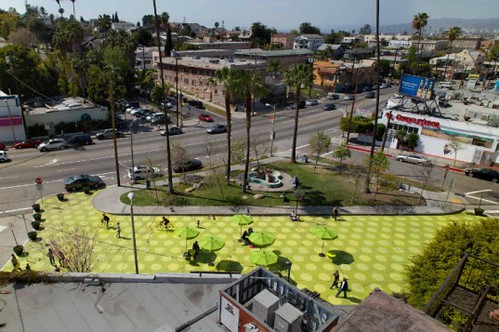
Sunset Triangle Plaza, Rios-Clementi-Hale-Studios
But not in the DC area, at least in terms of making over parking spaces permanently for parklets and patios.
Although we have to acknowledge the greater use of space formerly dedicated to parking for bike lanes and bike parking.
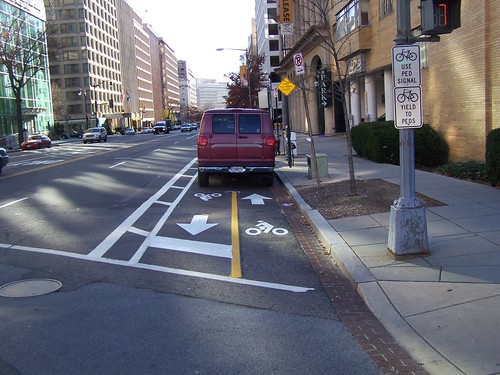
15th Street NW cycletrack in early stages, when drivers still were learning about them.

Bicycle corral, 11th Street NW, Columbia Heights
And some other examples of redirecting interstitial spaces away from the car. Foremost was the taking away of traffic lanes in 2005/2006 to expand Thomas Circle, returning it to its original size in a move that pre-dated the parklet movement.
This example from the northeast corner of the intersection at 5th Street and New York Avenue NW is more recent.
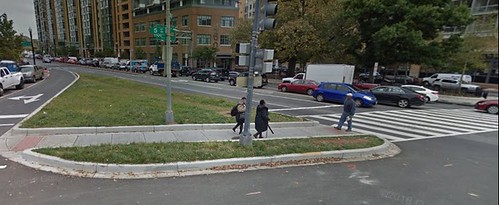
2017
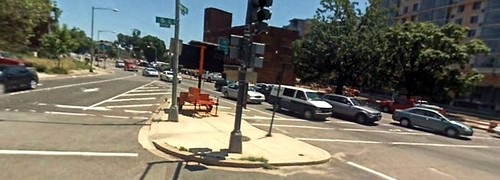
2008
So I was surprised yesterday to see that in Takoma Park,Maryland, the Takoma Beverage Company has expanded their restaurant patio into the parking lane, taking up
Note that Takoma Bev Co is a combo "coffee shop" and bar and the food is good, and reasonably priced.
I believe it is the first example in DC, Montgomery County, Arlington County, or Alexandria where "interstitial parking space" is being dedicated permanently to parklet-type use.
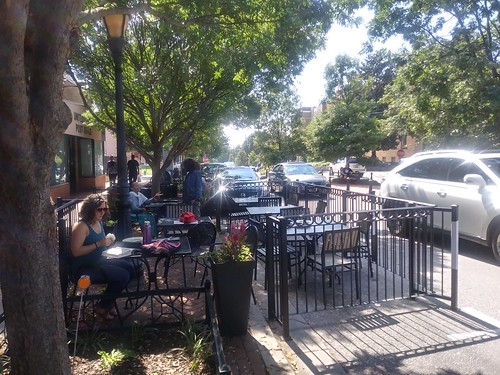
According to Suzanne Ludlow, City of Takoma Park City Manager:
As you may have noticed, Takoma Beverage Company is the first of our local restaurateurs to take advantage of the City’s new Outdoor Café Permit, approved by the Council this past summer. The new permit allows businesses like Takoma Bev Co. to offer outdoor seating to patrons wishing to take full advantage of their menu offerings.
The permit, which allows for the use of the City’s right of way (which can include on street parking spaces), requires the business to submit a site plan illustrating how the outdoor café will be laid out, provide liability coverage for the City, and be in full compliance with all food and beverage requirements established by Montgomery County.
Permits can be issued for three month, six month, or twelve month periods. The outdoor locations will be monitored on a regular basis by City staff to ensure that sidewalks allow for the free flow of pedestrians and that the business is complying with a variety of other local laws including the polystyrene ordinance and the property maintenance code.
The one tricky thing is on Sundays, when this space is used by the Takoma Farmers Market. It has to be pulled up then.
The new extended patio has been in place for not quite two weeks.
Labels: car culture and automobility, pedestrian planning, urban design/placemaking



0 Comments:
Post a Comment
<< Home